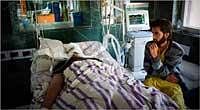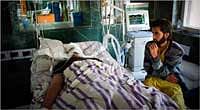

Nabi was the 50th person to die in Kashmir’s bloody summer of rage. He had been shot in the head, his family and witnesses said, during a protest against India’s military presence in this disputed province.
For decades, India maintained hundreds of thousands of security forces in Kashmir to fight an insurgency sponsored by Pakistan, which claims this border region, too. The insurgency has been largely vanquished. But those Indian forces are still here, and today they face a threat potentially more dangerous to the world’s largest democracy: an intifada-like popular revolt against the Indian military presence that includes not just stone-throwing young men but their sisters, mothers, uncles and grandparents.
The protests, which have erupted for a third straight summer, have led India to one of its most serious internal crises in recent memory. Not just because of their ferocity and persistence, but because they signal the failure of decades of efforts to win the assent of Kashmiris using just about any tool available: money, elections and overwhelming force.
“We need a complete revisit of what our policies in Kashmir have been,” said Amitabh Mattoo, a professor of strategic affairs at Jawaharlal Nehru University in New Delhi and a Kashmiri Hindu. “It is not about money — you have spent huge amounts of money. It is not about fair elections. It is about reaching out to a generation of Kashmiris who think India is a huge monster represented by bunkers and security forces.”
Indeed, Kashmir’s demand for self-determination is sharper today than it has been at perhaps any other time in the region’s troubled history. It comes as — and in part because — diplomatic efforts remain frozen to resolve the dispute created more than 60 years ago with the partition of mostly Hindu India and Muslim Pakistan. Today each nation controls part of Kashmir, whose population is mostly Muslim.
Secret negotiations in 2007, which came close to creating an autonomous region shared by the two countries, foundered as Pervez Musharraf, then Pakistan’s president, lost his grip on power. The terrorist attacks in Mumbai by Pakistani militants in 2008 derailed any hope for further talks.
Not least, India has consistently rebuffed any attempt at outside mediation or diplomatic entreaties, including efforts by the United States. The intransigence has left Kashmiris empty-handed and American officials with little to offer Pakistan on its central preoccupation — India and Kashmir — as they struggle to encourage Pakistan’s help in cracking down on the Taliban and other militants in the country.
With no apparent avenue to progress, many Kashmiris are despairing that their struggle is taking place in a vacuum, and they are taking matters into their own hands.
“What we are seeing today is the complete rebound effect of 20 years of oppression,” said Mirwaiz Umer Farooq, the chief cleric at Srinagar’s main mosque and a moderate separatist leader. Kashmiris, he said, are “angry, humiliated and willing to face death.”
International outcry
This summer there have been nearly 900 clashes between protesters and security forces, which have left more than 50 civilians dead, most of them from gunshot wounds.
While more than 1,200 soldiers have been wounded by rock-throwing crowds, not one has been killed in the unrest, leading to questions about why Indian security forces are using deadly force against unarmed civilians — and why there is so little international outcry.
“The world is silent when Kashmiris die in the streets,” said Altaf Ahmed, a 31-year-old schoolteacher. On Tuesday, Prime Minister Manmohan Singh made an emotional appeal for peace.
“I can feel the pain and understand the frustration that is bringing young people out into the streets of Kashmir,” he said in a televised speech. “Many of them have seen nothing but violence and conflict in their lives and have been scarred by suffering.”
Indeed, there is a palpable sense of opportunities squandered. Despite the protests of recent years, the Kashmir Valley had in the past few years been enjoying a season of peace.
The insurgency of the 1990s has mostly dried up, and elections in 2008 drew the highest percentage of voters in a generation. High expectations met the new chief minister, Omar Abdullah, a scion of Kashmir’s leading political family, whose fresh face seemed well suited to bringing better government and prosperity to Kashmir.
But election promises, like repealing laws that largely shield security forces from scrutiny and demilitarising the state, went unfulfilled. After two summers of protests on specific grievances, this summer’s unrest has taken on a new character, one more difficult to define and mollify.
That anger has led to a cycle of violence that the Indian government seems powerless to stop. Events that unfolded last week in Pulwama, a small town 20 miles from Srinagar, illustrate how the violence feeds itself.
It began on Aug 2, when a young man, Mohammad Yacoub Bhatt, from a village near Pulwama was shot dead during a march to protest the earlier killings of other young protesters.
Four days later, a procession set off to protest his death. Soon it swelled into the thousands. The police blocked the road and refused to let the marchers pass, worried that the crowd would burn down government buildings, as previous crowds had.
What happened next is disputed. Protesters claimed that when they tried to surge through a barricade, the police opened fire.
“We did not think they would open fire,” said Malik Shahid, 17, who had joined the march. “There was no violence. It was a peaceful protest.”
First the police fired in the air, witnesses said, then into the scattering crowd. A bullet felled Shahid’s uncle, Shabir Ahmed Malik, a 24-year-old driver, and killed him on the spot.
Shahid, a 12th grader who hopes to become an engineer, said the latest violence was evidence to him that remaining part of India was impossible.
“If India took steps against those who kill us, maybe the people of Kashmir would be willing,” he said. “But when there is no justice how can we remain with India? They are not doing anything but killing. So we will just go for freedom.”
Official version
Commandant Prabhakar Tripathy, spokesman for the Central Reserve Police Force, the main paramilitary force trying to keep order in Kashmir, declined to comment on the episode but said that the protests were not as spontaneous as they appeared.
“Militants are just mingling with the crowd, firing bullets from the crowd,” Tripathy said.
“Now they are trying to raise this confrontation between the public and the security forces.”
“We are charging them with tear gas, rubber pellets, firing in the air, nothing works here,” he said. “When a crowd of thousands attacks the camp, what can you do?”
Indian officials have tried to portray Kashmir’s stone-throwing youths as illiterate pawns of jihadist forces across the Pakistan border and have suggested that economic development and jobs are the key to getting young people off the streets.
But many of the stone throwers are hardly illiterate. They organise on Facebook, creating groups with names like ‘I’m a Kashmiri Stone Pelter’. One young man who regularly joins protests and goes by the nom de guerre Khalid Khan has an MBA and a well-paying job.
“Stone pelting is a form of resistance to their acts of repression in the face of peaceful protest,” he said in an interview. “I would call it self-defence. Stones do not kill. Their bullets kill.”
Each death seems to feed the anger on the streets, creating new recruits for the revolt. Fida Nabi’s brother, Aabid, 21, watched over him as he drifted toward death this week, his head swathed in white bandages, his chest rising and falling to the ghostly rhythm of the ventilator.
Aabid thought he had his life all mapped out — making more than $200 a month as a news photographer. But since his brother was shot his priorities have changed. “I used to cover the protests,” he said. “But now I will join them.”